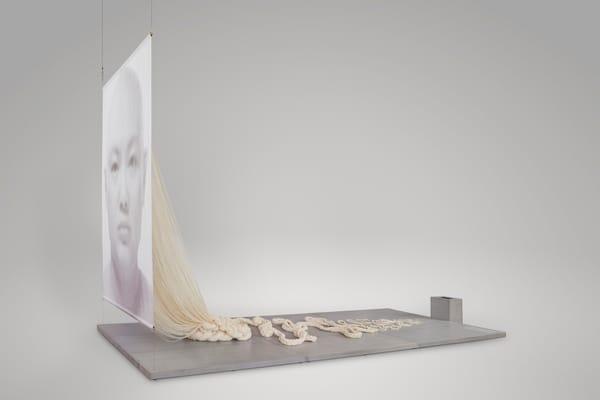Shows
“How far can we see within?” at La Centrale galerie Powerhouse


“How far can we see within?”, curator and artist 安媛 An Laurence’s exhibition of three Chinese Québécois artists, is an exploration of identity strained by transnational adoption. The show opens with visual artist 童宙 Tong Zhou Lafrance’s handwoven scrolls From China, To Canada I and II (both 2021). The long landscapes of an undiscerning horizon of green foliage and blue sky are hung vertically just far back from the gallery’s window enough to be inviting but inaccessible. Their placement destabilizes the viewer and approximates the artist’s frustration in accessing the details of their own journey.

Along the left wall beside it, visual artist Corinne Beaumier extends the sentiment with five works from her series Le fond et la forme (2013–14). The series comprises intricate jianzhi (Chinese paper cuttings) that are executed using personal photographs. Vastly obscuring the perception of their initial form, the series demonstrates the impossibility of reconstituting a complete image of her history from disconnected documents. In Jardins (2013), a floral motif is cut into an unassuming landscape in the form of a vesica piscis. A portrait of a man and another unidentifiable person have been so significantly cut into an outline of fenghuang (mythological bird) in Premiers contacts (2013) that they are easy to miss at first glance. The woodcut-like outline of a building and the surrounding landscape in Portrait (2013) renders the original document impossible to discern. Parents (2014) fashions a group portrait into a “Yi Jing” bagua arrangement with the caricature of a human in each hexagram. The passport image of a baby is cut into 福, the Chinese character for fortune, in Passeport (2013). The tedious process of cutting away fragments in the making of Le fond et la forme mirrors the labor necessary for those internationally adopted to deconstruct an obscured history of their own lives.

Photographs taken by Lafrance’s adoptive mother during the adoption trip frame the right side of the gallery’s front room. Lafrance shreds and stitches together the enlarged photographs of Chinese people at work in the series Untitled Labour (2022). Imbued with the nostalgia of their origin story, the photographs document memories pulled apart and painstakingly put back together again with nothing more to show for the effort than Lafrance’s labor. Lafrance’s Birth of Home (2018) is a commanding presence in the left corner. The four-feet textile in the shape of a uterus that hangs on one wall connects to a foam house on the opposite connecting wall by what appears to represent an umbilical cord. A photograph of the eight-minute performance that activates these textiles hangs on the wall in between. Taking inspiration from Louise Bourgeois’s Femme Maison (1946–47), Lafrance confronts the ambiguity surrounding their birth and symbolically births their own home.

Beaumier’s diptych Couleurs non imprimables (2013) leads the viewer into the back gallery. A landscape pulled from the artist’s personal archive was degraded into an outline by programming a printer to reject certain colors denoting the fallible nature of memory. She communes with her past in Conversation (2013), an over two-minute video work that superimposes film of the artist as an infant and as an adult. The images glitch and overlap until Beaumier waves her hand through the screen, as if cleaning a window, and brings clarity to the present. Both works are part of her Évidence (2013) series.
Laurence’s Come Closer, I’ll tell you what I forgot (2021) installation closes the show with a painful polyphonic exploration of the question that agonizes many adopted children, “Why?” Listening to one story after another it becomes clear that they are fantasies manifested by collective memory, used to frame the limited details of the artist’s surrender to an orphanage amidst the Chinese Family Planning Policy (1979–2016). As gallery visitors move through the installation, they must be mindful of the two cardboard boxes filled with blankets, photographs, and personal notes that lay on the ground with small lights. Listening to each audio in succession, the visitor retraces the parent’s steps by slowly moving away to view a box emptied of its baby forcing the question, “Are they okay?”
“How far can we see within?” runs from September 8 to November 3, 2022 at La Centrale galerie Powerhouse in Montreal, Canada.







